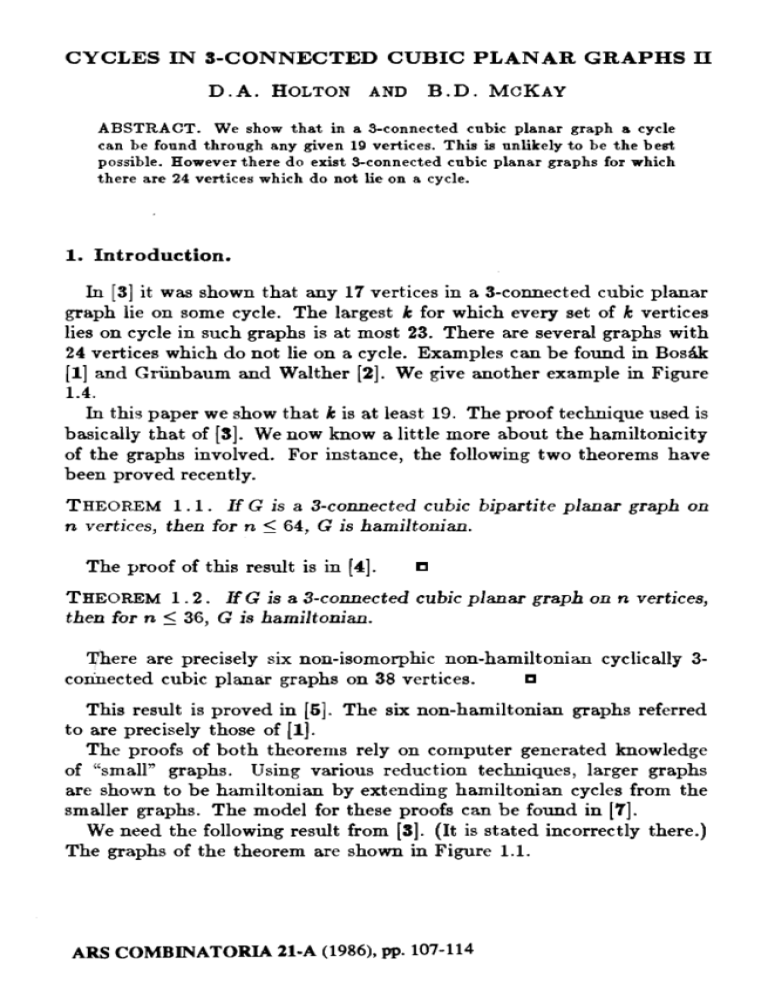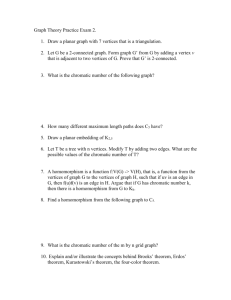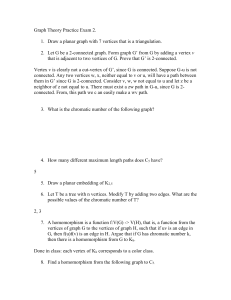CYCLES IN 3-CONNECTED CUBIC PLANAR GRAPHS I1 D . A
advertisement

CYCLES IN 3-CONNECTED CUBIC PLANAR GRAPHS I1
D . A . HOLTON AND B . D . MGKAY
ABSTRACT. We show that in a %connected cubic planar graph a cycle
can be found through any given 19 vertices. This is unlikely to be the best
possible. However there do exist %connected cubic planar graphs for which
there are 24 vertices which do not lie on a cycle.
1. Introduction.
In [3] it was shown that any 17 vertices in a 3-connected cubic planar
graph lie on some cycle. The largest k for which every set of k vertices
lies on cycle in such graphs is at most 23. There are several graphs with
24 vertices which do not lie on a cycle. Examples can be found in Bosak
[l]
and Griinbaum and Walther [2]. We give another example in Figure
1.4.
In this paper we show that k is at least 19. The proof technique used is
basically that of [S]. We now know a little more about the hamiltonicity
of the graphs involved. For instance, the following two theorems have
been proved recently.
THEOREM
1.1. If G is a 3-connected cubic bipartite planar graph on
vertices, then for n < 64, G is hamiltonian.
n
The proof of this result is in [4].
THEOREM
1 . 2 . JfG is a 3-connected cubic planar graph on n vertices,
then for n 36, G is hamiltonian.
<
There are precisely six non-isomorphic non-hamiltonian cyclically 3coimected cubic planar graphs on 38 vertices.
This result is proved in [S]. The six non-hamiltonian graphs referred
to are precisely those of [I].
The proofs of both theorems rely on computer generated knowledge
of "small" graphs. Using various reduction techniques, larger graphs
are shown to be hamiltonian by extending hamiltonian cycles from the
smaller graphs. The model for these proofs can be found in [7].
We need the following result from [3]. (It is stated incorrectly there.)
The graphs of the theorem are shown in Figure 1.1.
ARS COMBINATORIA 21-A(1986). pp. 107-114
THEOREM1 . 3 . Let G be a 3-comected cubic planar graph. Let A
VG be such that [A1 < 12 and Jet e l 6 EG. Then there is a cycle C in
G with A V C and e' $ E C unless there is a contraction <f> : G + T
with <fi{A)2 {I, 2 , 3 , 4 , 5 , 6 , 7 , 8 , 9 lo}
, and < f > ( e l )= e , or a contraction if) :
G -> Di, for i = l , 2 ,...,7 with d ( A ) = {1,2,3,4,5,6,7,8,9,10,11,12}
and <f>(el)= e.
o
Figure 1.1
108
Figure 1.1 (continued)
An a-edge is an edge which is on every hamiltonian cycle in a graph.
The edges e of Figure 1.1 are all a-edges. A 6-edge is an edge which is on
no hamiltonian cycle in a graph. Figure 1.2 shows the unique smallest
3-connected cubic planar graph which has a 6-edge (both (0,3) and (4,7)
are 6-edges). There are 7 graphs with a 6-edge on 26 vertices.
-3
Figure 1.2
If E is a cutset of a graph G consisting of three independent edges,
then the graphs G i , G 2 obtained from G by contracting a component
of G - E to a vertex are called 3-cut reductions of G. These 3-cut
reductions are shown diagrammatically in Figure 1.3.
The graph B of Figure 1.2 has the property that there is no cycle
through the 6-edge (0,3) and all of the vertices 1,2,4,5,6,7,8,10,12,13,14,
Figure 1.3
15,18,22,23. Neither is there a cycle through the 6-edge (4,7) and all of
the vertices 0,1,2,3,5,6,8,10,12,13,14,15,18,22,23. Hence we may join B
and the graph T of Figure 1.1 t o give a graph H so that (i) B s a d T
are the 3-cut reductions of H and (ii) a b-edge of B corresponds to the
a-edge of T (see Figure 1.4).
Now H has the property that it contains 24 vertices which do not lie
on a cycle. These vertices are either of the two sets of 15 vertices listed
in the previous paragraph and 9 of the 10 labelled vertices of T.
This can be seen by noting that if we avoid the edge "en of Figure 1.4
we cannot find a cycle through the 9 vertices of "T" and an arbitrary
vertex of "B" (Theorem 1.3). On the other hand if we use "en we must
use "bn and then we cannot find a cycle through the 15 vertices of "5"
specified earlier.
Ill
Figure 1.4
2. The main result.
In this section we prove the following theorem.
THEOREM2 . 1 . Let G be a 3-connected cubic planar graph and let
A C VG such that [A1 19. Then there exists a cycle C in G such that
A C VC.
<
PROOF: The method of proof closely follows that of Theorem 1 in [6].
We proceed by induction. By Theorem 1.2 we may assume that \VG\
38.
>
Case 1. G is cyclically 3-connected but not cyclically 4-connected. Thus
G has an edge cut E with three edges. Form the edge cut reduction
defined in Section 1to give graphs G I and G2. Let Ai = (AnVG;)u{ui}
for i = 1 , 2 where v; 6 VG; - VG. Assume without loss of generality
that \Ail 5 /A21. Hence lAll <. 10. Since IVG21 < \VG\ there exists a
cycle C2 in Ga through the vertices A t . This cycle will not include one
of the edges, e2, of E G 2 - E G . Let el be the edge of E G l - E G which
corresponds to 62.
If 1A21 < 9, then by Theorem 1.3 there exists a cycle Cl in Ga through
the vertices of Al and avoiding el. Cycles corresponding to C l and C2
in G can be combined to give the cycle C required by the theorem.
Suppose lAil = 10. Then we can repeat the argument of the last
paragraph unless G I is contractible to T. In this case let Cl be a cycle
in Gl such that Ai C VCl and let e l , e[ â ECl U ( E G l - E G ) where
el corresponds to the a-edge in T. Further let e2, et, be the edges of
EG2 - E G corresponding to el, e\. Now IA21 = 11, so there is a cycle
C2 in GI through Aa and e2, e i unless G2 is also contractible to T.
Hence if e! is the third edge of E G y - E G , then this must correspond to
the a-edge in T. Thus G must be contractible to the graph J of Figure
2.1. Since 3 is hamiltonian there exists a cycle in G through all the
vertices of A.
(The labels on the vertices of J correspond to those of T in Figure
1.1. The arrows on edges of J indicate the hamiltonian cycle.)
Figure 2.1
Case 2. G is cyclically 4-connected. If G contains an edge f whose end
vertices are not incident with a vertex of A then perform the f-reduction
of Figure 2.2. Since Gf is 3-connected then there exists a cycle in Gf
through the vertices of A which may be extended to a cycle in G through
A.
f-reduction
Figure 2.2
Hence we may assume that every edge of G is incident with some
38. But \VG\
38 by Theorem 1.2.
vertex of A. Therefore \VG\
Thus \'VG\ = 38 and G is bipartite. The theorem now follows since
Theorem 1.1 shows that G is hamiltonian.
o
<
>
REFERENCES
1. J. Bos&k, Private communication to B. Grunbaum, 1971.
2. B. Griinbaum and H. Walther, Shortneu exponents of arapfu, J . Comb. Th. 14A
(1973), 364385.
3. D.A. Holton, Cycles in 3-connected cubic planar graphi, Annals of Discrete Math.
2 7 (1985), 219-226.
4. D.A. Holton, B. Manvel and B.D. McKay, H a d o m ' a n cycles in cubic 3-connected
bipartite planar graphs, (subnu'fted).
5. D.A. Holton and B.D. McKay, The smallest non-hanuHonian cubic 3-connectedplanor graph have 38 vertices, {submitted).
6. D.A. Holton, B.D. McKay, M.D. Plummer and C. Thomassen, A nine pointfheorem for 3-comctedgraphs, Combinatoria 2 (1982), 53-62.
7. H. Okamura, Every mmple 3-polytope of order Sf? or less ii hamltonian, J . Graph Th.
6 (1982), 185-196.
Department of Mathematics and Statistics
University of Otago









